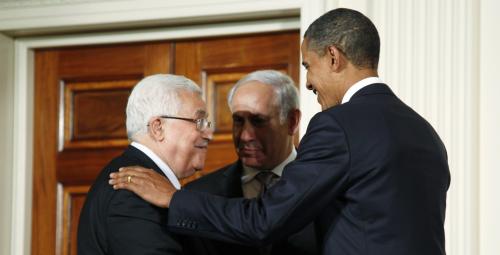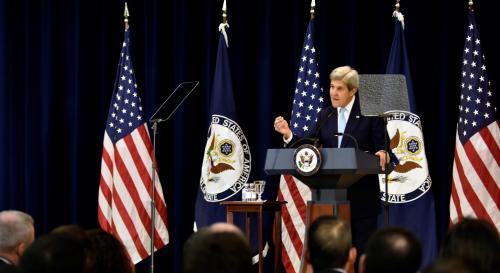The U.S. election result last week generated more questions than it answered. Among them is whether President Obama will issue a parting statement regarding the Israeli-Palestinian conflict. In July, Ariella Plachta and I argued that should the American people elect Hillary Clinton, the Obama administration would likely stay silent regarding the peace process, in order to better position Secretary Clinton to take ownership of the issue. However, we also wrote that if Donald Trump were elected, the administration would “have nothing to lose in revealing the fruits of its efforts in 2013-14.”
With Trump headed to the White House, the outgoing administration’s calculus is complicated. Obama, Kerry, and their advisers must now weigh whether the benefits of a parting shot outweigh the costs. It is clear that any effort will be symbolic at most. Either of the options on the table—a U.N. Security Council resolution (UNSCR) or the announcement of some sort of Obama/Kerry Parameters—will likely elicit an immediate denial and rejection by both Prime Minister Netanyahu and President Abbas. The leaders have their own domestic concerns that would make owning an Obama/Kerry Parameters document impossible. This was clear in Netanyahu’s recent address, in which he asked Obama not make any moves on the peace process during his remaining time in office.
Thus, in deciding whether to act on the conflict, the administration must evaluate a combination of personal and legacy implications, as well as its ability to influence the conflict many years down the road.
An attempt offers some clear benefits
By acting now, the Obama administration can put down markers for the next attempt at a negotiated settlement to the conflict. While the Trump administration is not likely to make a serious push to solve the conflict, at least in the near term, a public document laying out how far the parties came both preserves the hard work of the Kerry team and allows those outside of government to understand internal dynamics and devise possibilities for the way forward, should negotiations re-start at some point in a future administration.
Another benefit of releasing Obama/Kerry parameters is that it would dispel two myths: first, that the 2013-2014 effort was just the latest in a long-line of failed negotiations; and second, that the parties are not ready to make the serious compromises necessary for peace. Rather, a public document would highlight just how far both the Israelis and the Palestinians came on some of the final status issues, which could give fuel to the pro-peace camps on both sides of the conflict.
Additionally, making one final attempt, however symbolic, could help the administration go out on a high noted regarding the Israeli-Palestinian conflict. As President Obama and his team work to solidify his legacy as president, they might consider a parting shot aimed at selling the 2013-2014 negotiations as a win rather than a loss.
But a gamble nonetheless
However, releasing a public document or submitting a UNSCR has the potential to backfire in the legacy department. Rather than highlighting the administration’s success, it could shed light on an area where the administration ultimately failed. As of now, having signed the new 10-year security assistance Memorandum of Understanding (MOU) with Israel in September, President Obama will go down in history as the president under whom Israel received its largest military aid package and most comprehensive missile defense funding of any U.S. president. Thus, it is not necessarily in the administration’s interest to re-open the legacy file in regard to the U.S.-Israel relationship.
Furthermore, compared to the rest of the region, the Israeli-Palestinian arena is relatively calm. With only two months remaining in his presidency, Obama is likely to focus on securing the areas and issues—both foreign and domestic—most likely to come under threat in a Trump administration.
[S]taying silent on what are increasingly egregious violations of the long-understood commitment by the Israelis to preserve the possibility of a two-state solution is probably a pill too bitter for Obama to swallow.
Taking the middle road
A third option, which I think is most likely, is for the administration to stay silent on negotiations but to remove some of the shackles around how issues like settlements, home demolitions, and other human rights abuses are treated. These are moves that the administration has deemed “counterproductive” to a successful resolution to the conflict.
While the administration has been generally unwillingly to take a strong stand on these issues during the past eight years, recent rhetoric—even before November 8—has been more critical of both building or expanding settlements and legalizing outposts. In October, the State Department issued an uncharacteristically strong statement, “strongly condemning” the Israeli government’s decision to build a new West Bank settlement that would effectively bifurcate the West Bank, and calling into question “Israel’s commitment to achieving a negotiated peace.” The statement went so far as to reference the U.S.-Israel MOU—an attempt to remind the Israeli government that $38 billion should buy adherence to common practices, such as refraining from building deep into the West Bank, and a respect for the two-state solution.
In addition to press statements, the Obama administration could support a UNSCR related to settlements, taking the unprecedented step of voting against Israel in the U.N. But, much like issuing a parting shot, press statements (or private diplomacy) by the lame duck administration are unlikely to have any impact on the Netanyahu government. But staying silent on what are increasingly egregious violations of the long-understood commitment by the Israelis to preserve the possibility of a two-state solution is probably a pill too bitter for Obama to swallow. Rather, speaking out more forcefully against actions the U.S. government perceives as harmful to any potential peace process allows the US administration to make its positions known without investing any major time, effort, or political capital on an issue they will not be able to fix before January 20.





Commentary
With Trump coming to the White House, what’s Obama’s exit calculus on the peace process?
November 16, 2016